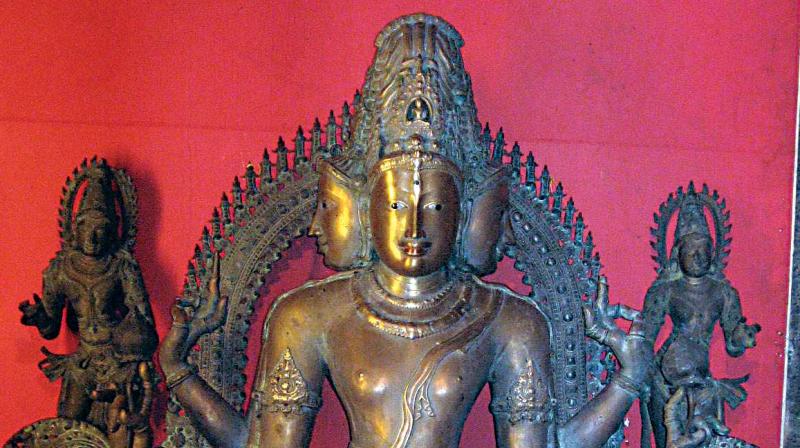Sunday story: The Buddha towers.... in Karnataka's coast too!
Historic finds which have tremendous significance, often happen unexpectedly.

Those familiar with Buddhism would know that Harithi is the fertility goddess and is usually seen with a child. The Harithi idol in Soraba is considered unique by historians and is one among the recent Buddhist findings in the Malnad-coastal Karnataka region. It proves that places which hitherto, were considered outside the sphere of influence of Buddhism, had also gone through a Buddhist phase. There is no dearth of religious sites in coastal Karnataka. Gokarna, Sringeri, Kukke Subrahmanya, Kollur, Kateel, Udupi, Bahubali of Karkala and Venur, the Thousand Pillar Basadi, Chapel of St Aloysius, Attur Church, Sayyed Madani Dargah of Ullal...... the list of Hindu, Muslim, Christian and Jain religious places is unending.
Now with the discovery of the Harithi idol, it has been proved that Buddhism too had cast its magnetic sway among people of a bygone age in this region. It's not only the Harithi idol, damaged Buddhist idols have been found in Pervaje proving that the religion was popular in Dakshina Kannada and Udupi. Gradually, as Hinduism became popular drawing more and more people into its fold, Buddhist centres lost their relevance. Some continued to survive with changes, others turned from monastries to temples! According to Prof. Murugeshi, the advent of Buddhism in the region dates back to the 3rd century BC and it continued to wield influence till the 10th century.
Hinayana Buddhism was the first to enter the region, which transformed to the Mahayana and Vajrayana streams before it declined. “It was Emperor Ashoka, an ardent Buddhist, who popularised the religion by sending Dharmarakkita to Banavasi (in Uttar Kannada district). This finds mention in Ashokan inscriptions and Buddist literature and indicates that Banavasi was a major Buddhist centre,” Prof Murugeshi says. Considered one of the oldest living towns in Karnataka, Banavasi had trade and commerce links with other centres since the 3rd century BC. “Nagarjuna, the most important philosopher of the Mahayana sect, was from South India and thus Mahayana Buddhism became popular in Banavasi. Proof of this is found in the texts of Chinese traveller Hiuen Tsang (Xuanzang) who visited Banavasi in the 7th century. He speaks of an image of Buddha being taken in a palanqin in a procession. In the Mahayana stream of Buddhism, Buddha is worshipped as a god and so we can conclude that Mahayana was very popular in Banavasi then,” explains the historian. The ruling elite did their bit to popularise the religion. Bojaru was the ruling Buddhist family in Uttar Kannada.
There are inscriptions of them building Baudha Vihara. Places like Banavasi, Haigunda (in Uttara Kannada district), Hattiyan gadi, Mandarthi, Kalyanpur, Mulur (in Udupi district) and Kadri in Dakshina Kannada district still have evidence of Buddhist worship. The remains of a structure, said to be a Buddhist stupa, exist near Hanglur in Kundapur taluk. “Kadri was a major Buddhist centre since the 2-3rd century. The cave in the Kadri hill could date back to the 2nd or 3rd century. Alupa King Kundaverma who installed a massive Lokeshwara idol, mentions 'Kadarika Vihare' in the inscription below the idol. Vihara is the word used for a Buddhist centre. The small stambha (pillar) inside the temple has a ‘Dhayana Buddha’, carving. With so much evidence, we can conclude that Kadri was a major Buddhist centre,” he says adding that Mandarthi temple too could have been a Buddhist centre. “Historians have discovered a Harithi idol in the temple premises. I feel 'Maha Harithi,' might have evolved into 'Mandarthi.”
Buddhism started declining in the country around the 7-8th century and this had its impact on the coastal districts too. “The Chalukyas of Badami preferred Hinduism (which had by then been revived by Adi Shankaracharya) and soon, other kings too gave up their support to Buddhism. With royal patronage declining, the religion suffered,” he said. And what finally happened to the famed Buddhist centres in the coast? Some made the transition to Hindu centres. Classic examples are Kadri, Mandarthi and Muluru in Udupi. In Muluru, the idol of Buddha which dates back to the 7th century, is worshipped today as Lord Vasudeva! In Kadri the Buddhist idols have not been destroyed and have been shifted and kept aside. Only the main deity has changed from the Buddhist deity Manjughosha to Lord Manjunatha (Shiva).
The vagaries of time also led to the destruction of many idols. “We have discovered several idols in Pervaje village in Dakshina Kannada where the face and other parts of the idols have been chopped off or destroyed deliberately” reveals the professor. Buddhism continues to influence millions not only in India but across the globe, like Hinduism because of the enduring strength of its basic tenets. In Kadri and Soraba, a thousand years ago, people embraced the Buddha's thoughts like a lifeline, as they struggled to fight off the forces of nature and the many foes they had to face. A thousand years later, the Buddha remains a beacon of idealism and hope in a world increasingly bereft of icons and fast losing its moorings.

